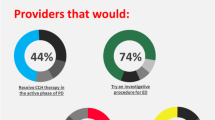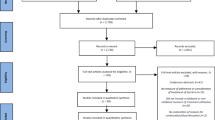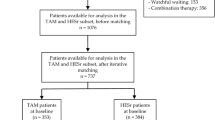Abstract
With increasing media interest in prostate cancer and the availability of data to patients from support groups and the Internet, the knowledge and use of alternative therapies by patients is becoming more common. The purpose of our study was to quantify patient awareness and use of alternative therapies for the prevention and treatment of prostate cancer in the UK. In May 2000, we performed a survey of men attending our urology outpatient clinic for prostate cancer evaluation or follow-up. All men diagnosed with and those at high risk (abnormal prostate specific antigen) for prostate cancer were eligible for the study. Each eligible patient was then sent an anonymous 25-item questionnaire to explore their knowledge and use of various alternative therapies for prostate cancer. Out of 195 patients who were sent the questionnaire, 168 responded, for a response rate of 86%. One hundred and sixty-four were analysed. Eight-two out of 164 (50%) were aware of alternative therapies for prevention/treatment of prostate cancer, the most common were tomatoes/tomato-based products and low-fat diet. There were 27 (16.5%) respondents taking alternative therapies for their prostate. Private patients were more aware (60.4% private vs 46.2% NHS) of complimentary therapies and were more likely to take them (27.9% private vs 12.4% NHS) than National Health Service patients. The majority of patients (60%) had not informed their GP or urologist. Fifteen therapies and 12 medication sources were recorded. Asked if doctors should discuss non-prescribed therapies, even if there is no proven benefit, 62% said ‘yes’ while 29% said ‘no’. Alternative therapy use for prostate cancer is likely to increase. If we don't ask patients specifically whether they are taking them, patients are unlikely to tell us. Urologists and clinical oncologists treating men with prostate cancer need to be aware of alternative therapies and have some understanding of any benefit or harm, not only to be able to answer patient's questions and offer advice, but also to consider interactions with other treatments.
.
This is a preview of subscription content, access via your institution
Access options
Subscribe to this journal
Receive 4 print issues and online access
$259.00 per year
only $64.75 per issue
Buy this article
- Purchase on Springer Link
- Instant access to full article PDF
Prices may be subject to local taxes which are calculated during checkout
Similar content being viewed by others
References
Rees L, Weil A Integrated medicine—imbues orthodox medicine with the values of complimentary medicine. Br Med J 2001 322 119–120
Eisenberg DM et al Trends in alternative medicine use in the United States, 1990–1997: results of a follow-up national survey. JAMA 1998 280 1569–1575
Eisenberg DM et al Unconventional medicine in the United States. Prevalence, costs, and patterns of use. New Engl J Med 1993 328 246–252
Reilly D, Taylor M Developing integrated medicine report of the RCCM research fellowship in complimentary medicine the University of Glasgow 1987—1990.
Dolan G, Lewith GT The practice of complementary medicine outside the NHS. J Altern Complement Med 1999 5 297–300
Zaichick V, Ye Sviridova TV, Zaichick SV Zinc in the human prostate gland: normal, hyperplastic and cancerous. Int Urol Nephrol 1997 29 565–574
Massion AO et al. Meditation, melatonin and breast, prostate cancer: hypothesis and preliminary data. Med Hypoth 1995 44 39–46
Moses MA, Sudhalter J, Langer R Identification of an inhibitor of neovascularisation from cartilage. Science 1990 248 1408–1410
Pinto JT et al Effects of garlic thioallyl derivatives on growth, glutathione concentration, and polyamine formation of human prostate carcinoma cells in culture. Amer J Clin Nutr 1997 66 398–405
Hsieh T et al. Regulation of androgen receptor (AR) and prostate specific antigen (PSA) expression in the androgen-responsive human prostate LNCaP cells by ethanolic extracts of the Chinese herbal preparation, PC-SPES. Biochem Molec Biol Int 1997 42 535–544
Shimada H, Tyler VE, McLaughlin JL Biologically active acylglycerides from the berries of saw-palmetto (Serenoa repens). J Nat Prod 1997 60 417–418
Clark LC et al and the Nutritional Prevention of Cancer Study Group Effects of selenium supplementation for cancer prevention in patients with carcinoma of the skin. A randomised controlled trial. JAMA 1996 276 1957–1963
Fleshner N, Huryk R, Heston W, Fair W Vitamin E inhibits the high-fat diet promoted growth of human prostate cancer LNCaP xenografts in athymic mice. J Urol 1998 159 13, abstract 50
Giovannucci E et al. A prospective study of dietary fat and risk of prostate cancer. J Natl Cancer Inst 1993 85 1571–1579
Schwartz GG, Hulka BS Is vitamin D deficiency a risk factor for prostate cancer? (Hypothesis). Anticancer Res 1990 10 (Suppl): 1307–1311
Adlercreutz H, Markkanen H, Watanabe S Plasma concentrations of phyto-oestrogens in Japanese men. Lancet 1993 342 1209–1210
Giovannucci E et al. Intake of carotenoids and retinal in relation to risk of prostate cancer. J Natl Cancer Inst 1995 87 1767–1776
Hellawell GO, Turner KJ, Le Monnier KJ, Brewster SF Urology and the Internet: an evaluation of internet use by urology patients and of information available on urological topics. Br J Urol Int 2000 86 191–194
Hirsch IH Integrative urology: a spectrum of complimentary and alternative therapy. Urology 2000 56 185–189
Gerber GS, Bales G, Kirsch E, Christiano AP Medicinal botanicals in the treatment of lower urinary tract symptoms (LUTS): a demographic analysis of awareness and use at the University of Chicago. J Urol 1998, part 2 159 334, abstract 1282
Nam RK et al. Prevalence and patterns of the use of complimentary therapies among prostate cancer patients: an epidemiological analysis. J Urol 1999 161 1521–1524
Risbserg T et al. Cancer patients use of nonproven therapy: a 5-year follow up study. J Clin Onco 1998 16 6–12
Spiegel D, Moore R Imagery and hypnosis in the treatment of cancer patients. Oncology 1997 11 1179–1189
Downer SM et al. Pursuit and practice of complementary therapies by cancer patients receiving conventional treatments. Br Med J 1994 309 86–89
Lerner IJ, Kennedy BJ The prevalence of questionable methods of cancer treatment in the United States. CA Cancer J Clin 1992 42 181–191
Kao GD, Devine P Use of complimentary health practices by prostate cancer patients undergoing radiation therapy. Cancer 2000 88 615–619
Rose DP, Cohen LA Effects of dietary menhaden oil and retinyl acetate on the growth of DU 145 human prostatic adenocarcinoma cells transplanted into athymic nude mice. Carcinogenesis 1988 9 603–605
West DW et al. Adult dietary intake and prostate cancer risk in Utah: a case–control study with special emphasis on aggressive tumours. Cancer Causes Control 1991 2 85–94
Walker AR et al. Case—control study of prostate cancer in black patients in Soweto, South Africa. Br J Cancer 1992 65 438
Small EJ et al Prospective trial of the herbal supplement PC-SPES in patients with progressive prostate cancer. J Clin Oncol 2000 18 3595–3603
Ashar B, Vargo E Shark cartilage—in induced hepatitis. Ann Int Med 1996 125 780–781
Patterson LR Drug evaluation memographs: warfarin. Micromedix 1998 97 Exp H/31/98
Gianni L, Dreidein WB Some popular herbs can interact with anticoagulant therapy. US Pharm 1998 5 80–86
Miller I Herbal medicinals: selected clinical considerations focussing on known or potential drug—herb interactions. Arch Intern Med 1998 158 2200–2211
Norheim AJ, Fonnebo V Adverse effects of acupuncture. Lancet 1995 345 1576
Author information
Authors and Affiliations
Appendix 1
Appendix 1
Questionnaire on patient awareness and use of alternative therapies for prevention or treatment of prostate cancer
Thank you for agreeing to complete this questionnaire. The information given will be processed in a confidential and anonymous fashion. Your comments are very much appreciated.
-
1
What problem are you consulting a urologist about? (Circle one) A prostate cancer B abnormal PSA (prostate specific antigen blood test) C not sure why
-
2
What is your age? (Circle one) A less than 40 B 41–50 C 51–60 D 61–70 E 71–80 F over 80
-
3
What is your race? (Circle one) A White Caucasian B European C African - Caribbean D Asian E Far Eastern F Other, please specify ………
-
4
What is your occupation? ………
-
5
Do you have a higher degree? (Please circle) Yes/No
-
6
Were you seen as an NHS or private patient? (Please circle) A NHS B Private
-
7
Are you aware that there are alternative therapies that, according to some reports, are for prevention and treatment of prostate cancer? (Circle one) A Yes B No
-
8
If you answered yes to Question 7, where did you learn about these alternative therapies? (Circle as many as appropriate) A newspaper B magazine C mens health magazine D the Internet E another person/friend/relative F GP G hospital doctor H other source—please specify ………
-
9
Have you heard about the association of any of the following in the prevention of prostate cancer? (Circle as many as you know) A low-fat diet B vitamin D C vitamin E D tomatoes or tomato based foods E garlic F selenium G brazil nuts H plant extracts I meditation J acupuncture K soya products, eg tofu, or Prevacan biscuit bar L zinc M Saw Palmetto N PCSPES
-
10
Have you ever been asked by a doctor in the urology clinic whether or not you take non-prescribed/alternative medication related for your prostate? A Yes B No
-
11
Have you ever thought about taking non-prescribed/alternative medication for the prevention of prostate cancer? (Circle one) A Yes B No
-
12
Have you ever taken any medication not prescribed by a doctor for your prostate? A If you answered ‘No’ to this question, please go straight to Question 23 B If you answered ‘Yes’ to this question, please continue with Question 13
-
13
Please state below what non-prescribed/alternative medicines you are taking/have taken, for your prostate ……… ………
-
14
Please state where you purchased your non-prescribed medication from A UK chemist B UK health food shop C supplied by post in response to UK newspaper/magazine advertisement D supplied by post in response to Internet advertisement E other, please specify ………
-
15
How long did you take it for? A less than one month B 3–6 months C 6–12 months D 1–2 y E more than 2 y F other, please specify ………
-
16
Did you tell your GP that you were taking non-prescribed/alternative medication? A Yes B No
-
17
If you answered ‘No’ for Question 16, please indicate why you did not tell your GP? A GP did not ask B thought GP would not be interested C thought GP would not approve D other reason, please specify ………
-
18
Did you tell the urology doctor that you were taking non-prescribed medication? A Yes B No
-
19
If you answered ‘No’ to Question 18, please indicate why you did not tell your urology doctor. (Circle one) A Dr did not ask B thought Dr. would not be interested C thought Dr. would not approve D other reason, please specify ………
-
20
If possible, please give an estimate of cost of your non-prescribed/alternative medication, per month (Circle one) A less than £5 B £5–10 C £10–15 D £15–20 E more than £20 F really don't know cost
-
21
Did you try other medicines because you were dissatisfied with what doctors had prescribed? A Yes please specify reason why ……… B No
-
22
Do you feel that you have had some benefit from your non-prescribed therapy? A Yes B No C Don't know
-
23
What medication are you taking for your prostate? A None B Only medicine prescribed by a doctor C Only alternative non-prescribed therapies D Both B and C
-
24
Has a doctor ever recommended non-prescription/alternative medicine to you for the prevention or treatment of prostate cancer? A Yes B No
-
25
Do you think doctors should discuss non-prescribed ‘alternative’ medicines with patients, even if there is no proven benefit for their use in humans? A Yes
This is the end of the Questionnaire. Thank you again for your time.
Rights and permissions
About this article
Cite this article
Cheetham, P., Le Monnier, K. & Brewster, S. Attitudes and use of alternative therapies in UK prostate cancer patients—isn't it time we were in the know?. Prostate Cancer Prostatic Dis 4, 235–241 (2001). https://doi.org/10.1038/sj.pcan.4500536
Received:
Revised:
Accepted:
Published:
Issue Date:
DOI: https://doi.org/10.1038/sj.pcan.4500536
Keywords
This article is cited by
-
Treatments for irritable bowel syndrome: patients' attitudes and acceptability
BMC Complementary and Alternative Medicine (2008)



